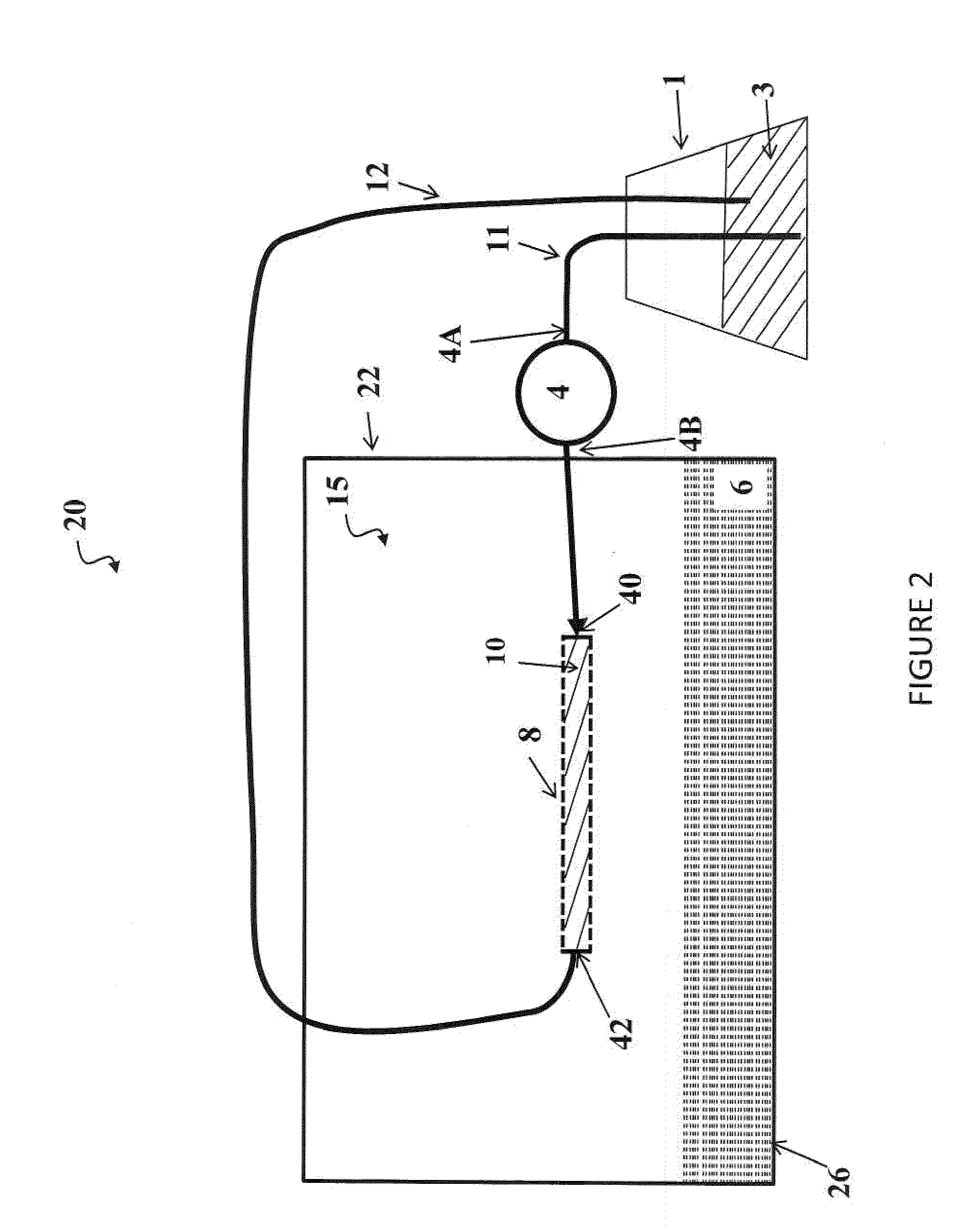Gaseous Ammonia Removal System
a technology of ammonia removal and ammonia gas, which is applied in the preparation of carboxylic compounds, separation processes, organic chemistry, etc., can solve the problems of affecting the health of workers and birds, affecting the conversion of feed and weight gain of birds, and high ammonia levels, so as to reduce the level of nh3
- Summary
- Abstract
- Description
- Claims
- Application Information
AI Technical Summary
Benefits of technology
Problems solved by technology
Method used
Image
Examples
example 1
[0058]This example includes four experiments for the process configuration wherein an acid solution is contained in an acid tank and was continuously recirculated into a chamber containing poultry litter (See FIG. 2). Once inside the chamber, the acid was contained inside a microporous, hydrophobic gas-permeable, tubular membrane 8 allowing for the passage of NH3 gas emitted by the litter and subsequent recovery and concentration of the N as an ammonium salt.
[0059]FIG. 3 shows a 2-L, polyethylene terephthalate (PET) plastic, wide-mouth jar 18 cm (h)×12 cm (dia) with a threaded polyethylene lid (Cole-Palmer, Vernon Hills, Ill., USA). There were a total of five ports in the lid of the chamber, two for acid inflow-outflow, one for venting air, through tubing with glass wool, to ensure ambient pressure and aerobic conditions inside the chamber, and the remaining ports, allowed headspace air sampling (only the inflow-outflow ports are depicted). Tygon tubing (approximately 4.75 mm I.D., ...
experiment 1
[0065]The first experiment was designed to determine the general feasibility of using ePTFE tubular membranes on the recovery of NH3 released from poultry litter. Three different ePTFE tubings were tested (Table 1 and FIG. 4), and identified as A, B, or C; distinguished by the following properties. Tubing A possessed an inner diameter of 4.00 mm, a wall thickness of 0.25 mm, and a bubble point of 34.5 kPa. Tubing B possessed an inner diameter of 5.25 mm, a wail thickness of 1.00 mm, and a bubble point of 241.3 kPa. Tubing C possessed an inner diameter of 8.75 mm, a wall thickness of 0.75 mm, and a bubble point of 206.3 kPa. The membrane tubing inside the chamber had the same length (approximately 66 cm) but varied in terms of wall thickness, pore size, and bubble points. Placement of the ePTFE tubing was approximately 5 cm above the litter surface (shown in FIG. 5A).
[0066]The membrane system recovered about 96% of the NH3 lost from the litter during the 21 day evaluation (FIG. 6, Ta...
experiment 2
[0067]The second experiment was designed to determine if placement of the ePTFE tubing with respect to the litter surface had an effect on NH3 recovery. Type B ePTFE tubing (Table 1) was used for this experiment. The tubing was placed inside the chamber in the following three positions (FIG. 5): (A) Above: approximately 5 cm above the litter surface; (B) On: laying directly on the litter surface, and (C) Under: below the litter and inside a pocket made of 300-μm nylon mesh (Krystal Klear Filtration, Winamac, Ind.) to support the tubing under the weight of the litter.
[0068]The relative position of the tubular membranes (above, on, or under the litter) did not significantly affect the total mass of NH3 recovery by the system (FIG. 7A, p=0.4776) nor the mass of the NH4-N remaining in the litter after volatilization (FIG. 7B, p=0.7908). Therefore, the results of the three treatments were pooled together to perform a weekly mass balance of the NH4-N in the chambers (Table 4). In terms of...
PUM
| Property | Measurement | Unit |
|---|---|---|
| weight | aaaaa | aaaaa |
| aerodynamic diameter | aaaaa | aaaaa |
| length | aaaaa | aaaaa |
Abstract
Description
Claims
Application Information
 Login to View More
Login to View More - R&D
- Intellectual Property
- Life Sciences
- Materials
- Tech Scout
- Unparalleled Data Quality
- Higher Quality Content
- 60% Fewer Hallucinations
Browse by: Latest US Patents, China's latest patents, Technical Efficacy Thesaurus, Application Domain, Technology Topic, Popular Technical Reports.
© 2025 PatSnap. All rights reserved.Legal|Privacy policy|Modern Slavery Act Transparency Statement|Sitemap|About US| Contact US: help@patsnap.com



